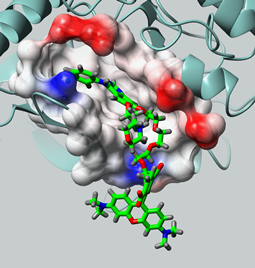
The department develops software for processing various kinds of experimental biological data, and for organising storage of data. We also have expertise in modelling and simulating biological systems.
Our work contributes to the fundamental understanding of how genes and
proteins operate, and has applications in drug development, crop science
and environmental monitoring. We are particularly interested in
computationally challenging problems, and apply high performance
computing and data intensive computing methods.
Computational Structural Biology
We develop, maintain and disseminate software for processing experimental data obtained from X-ray crystallography and electron cryo-microscopy. These techniques give an insight into the molecular details of proteins, nucleic acids and other molecules important to life. We coordinate software for the CCP4 and CCP-EM collaborations which allow the determination of structural models from X-ray crystallography and cryoEM respectively.
Key publication: M. D. Winn et al.
Acta. Cryst. D67 , 235-242 (2011) "Overview of the CCP4 suite and current developments"
[ doi:10.1107/S0907444910045749 ]
Key software: CCP4, CCP-EM
Molecular Modelling and Simulation
We perform atomistic and coarse-grained molecular simulations of biological systems, in support of grant-funded research and Hartree Centre projects.
Key publication: Hannes H. Loeffler, Julien Michel, and Christopher Woods (2015) “FESetup: Automating Setup for Alchemical Free Energy Simulations", J. Chem. Inf. Model., 55, 2485 - 2490 [ DOI: 10.1021/acs.jcim.5b00368 ]
Key software: FESetup, Longbow
Biological data
We are interested in the representation of biological data, through the development of data models and ontologies. We are also interested in exploring structured and unstructured data to gain additional insights.
Key publication: J.Ison,
C.Morris, et al. (2016) “Tools and data services registry: a community effort to document bioinformatics resources"
Nucleic Acids Research,
44, D38-D47
[ doi: 10.1093/nar/gkv111 ] Computational omics
We have applied high end computing techniques to improve the handling of large omics datasets. We are particularly interested in parallelizing bioinformatics codes to allow large datasets to be analysed on multi-node clusters. With the ability to study very large omics datasets, we are beginning to address new biological questions. This research area exploits the recent explosion in the generation of sequence data. There is a link to our interest in structural biology through the use of contacts predicted by evolutionary covariance, which are becoming more reliable with the increase in the number of related sequences that are available. We are working with the University of Liverpool to integrate contact information into the AMPLE software, and related applications.
Key publications:
Will Rowe and Martyn Winn (2018) “Indexed variation graphs for efficient and accurate resistome profiling" Bioinformatics, accepted. [ 10.1093/bioinformatics/bty387 ]
CS Kim, MD Winn, V Sachdeva, KE Jordan (2017) “K-mer clustering algorithm using a MapReduce framework: application to the parallelization of the Inchworm module of Trinity" BMC Bioinformatics, 18, 467. https://doi.org/10.1186/s12859-017-1881-8
Key software: AMPLE, Groot
